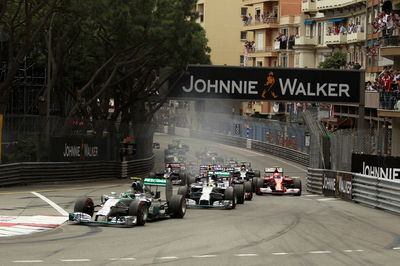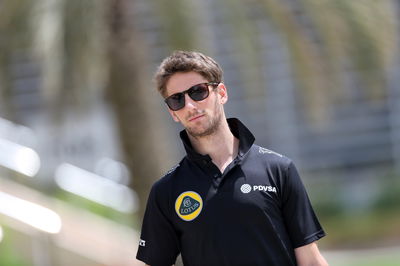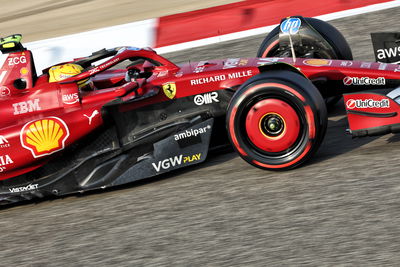Six of the Best: Overtakes at Monaco

The Monaco Grand Prix may be the 'jewel in the crown' of the Formula One season as far as the associated values of glitz, glamour and style are concerned, but the racing itself frequently leaves a lot to be desired.
The narrow, twisting ribbon of tarmac that makes up the Monte-Carlo circuit is notorious for being nigh on impossible to overtake on. There are exceptions to every rule however, with these six overtakes displaying a degree of nerve, opportunism and skill made all the more enjoyable by the rarity of their craft.
 |
| Michael Schumacher mastered a robust pass on Alex Wurz... though it ultimately ruined their races |
The Fairmont (formerly Loews) hairpin has always been one of the most iconic and photogenic sights on the Formula One calendar - a cartoonish switchback bend rotating through more than 180 degrees midway through a dramatic plunge from the heights of Casino Square to the waterfront Portier.
Its picture perfect nature belies an overtaking challenge like no other however, with concertina traffic jams, barrier bumping and beaching on the comically high kerbs the common consequence of optimistic manoeuvres such as Gerhard Berger's punt up the inside of Damon Hill in 1993, Olivier Panis's barge past Eddie Irvine in 1996 or Irvine's own wacky races nudge past Heinz-Harald Frentzen in 1998.
Whilst is possible to execute a clean pass at the Fairmont hairpin with the help of docile acquiescence from a rival (think Adrian Sutil on Fernando Alonso in 2013), Michael Schumacher's pass on Alex Wurz's Benetton in 1998 was a classic embodiment of the bump and grind school of thought.
Chasing down the second-placed Wurz on lap 38, Schumacher closed right up heading into Mirabeau as the Benetton hit traffic. Schumacher dived for the inside into the hairpin but Wurz refused to yield, and the two cars rounded the bend welded together on full opposite lock. Running down to Portier, Wurz remained level with Schumacher, and took the inside line into the first part of the corner. As Wurz slithered wide, Schumacher cut back underneath and dived for the inside as the cars turned into the tunnel. This time, there was a bigger bang, forcing Wurz offline (but not against the barriers) as Schumacher thrillingly muscled his way through.
The pass may have ultimately completely ruined both of their races, with Schumacher pitting for lengthy repairs to his suspension and Wurz suffering a huge accident coming out of the tunnel when he too fell victim to suspension damage, but for the joyous sight of two cars banging wheels, interlocked with no quarter given nor asked through some of Monaco's tightest and most challenging corners it deserves to be remembered through the rosiest of tinted spectacles.
Nico Hulkenberg on Kevin Magnussen - 2014
Given the limits on genuine overtaking opportunities around Monaco, opportunism is frequently the watchword behind any pass - with an ability to pounce on the slightest mistake from the car in front a pre-requisite for attempting an overtake at pretty much any point on the circuit.
One of the best overtakes of recent seasons saw Nico Hulkenberg catch Kevin Magnussen napping into Portier on lap 32 of last year's Monaco GP. As Schumacher's pass on Wurz showed, slinging a car down the inside here is almost a guarantee of contact, yet Hulkenberg was able to slip past Magnussen with a minimum of fuss.
As the cars exited turn seven, Hulkenberg's Force India was tucked right up behind Magnussen's McLaren. Not content to wait for an opportunity to get into Magnussen's slipstream and attempt a pass into the Nouvelle Chicance, Hulkenberg spotted a gap as Magnussen prepared to turn into Portier and took a narrow angle to launch his car at the apex.
Such a shallow corner entry took Hulkenberg off the racing line, but he was able to slow the car sufficiently to make the corner whilst avoiding contact with Magnussen, who remained committed to the turn. Putting the power down as they squirmed into the tunnel, Hulkenberg held the inside and forced Magnussen to back off in order to take the racing line through the flat-out right-hander.
Unorthadox? Certainly. Effective? Absolutely, and alongside Jules Bianchi's aggressive pass on Kamui Kobayashi into the Rascasse later in the race, a demonstration from the class of 2014 that the right blend of opportunism and aggression can turn any corner into an overtaking spot.
 |
| Kimi Raikkonen proved his mettle with a daring pass on Mark Webber at Massanet |
Monaco is such a tight circuit that even its straights are corners, with the three fastest parts of the circuit - the start/finish straight, the tunnel and the climb through Beau Rivage - all curved to an extent that cars traditionally cling religiously to a single racing line.
Whilst the start/finish straight and the tunnel offer heavy braking areas in which to try your luck into St. Devote and the Nouvelle Chicane respectively, Beau Rivage has no such luxury. The sequence up the hill and into the fast-paced Massanet and Casino corners has traditionally been a place to follow the leader and keep your powder dry for an attack into one of the more conventional passing spots.
Not so for Kimi Raikkonen in 2006 however. In keeping with the opportunistic theme, the then McLaren driver's pass on Mark Webber's Williams up the hill from St. Devote on lap two of the 2006 Monaco GP was a masterclass of the unexpected.
With Michael Schumacher relegated to the back of the grid following his infamous 'parking' incident at Rascasse in qualifying, Mark Webber's Williams was promoted to a rare front row start alongside polesitter Fernando Alonso.
Despite maintaining his place off the line however, Webber quickly fell out of the top two, as third placed starter Kimi Raikkonen launched a surprise assault on Webber at the start of lap two.
Within four tenths of the Williams as the cars entered St. Devote, Raikkonen pounced as Webber ran slightly wide through the first corner. Given that Beau Rivage is a winding ribbon of a straight, lined by weaving barriers, even a much faster corner exit would usually result in the driver behind backing off. Raikkonen though gave no such quarter, darting out from behind the Williams and powering past - taking the outside line around Webber into Massanet.
Sadly it made no difference to the outcome of the race, with both drivers retiring due to mechanical gremlins, but Raikkonen's pass remains an enduring testament to the power of Monaco opportunism.
Sergio Perez on Jenson Button and Fernando Alonso - 2013
Sometimes during a race a driver will develop an affinity with a certain corner, and execute the same passing manoeuvre on rivals repeatedly. Think of Kamui Kobayashi diving down the inside of several startled rivals into the hairpin at the 2010 Japanese Grand Prix - confidence on the brakes and the knowledge that a pass has worked before is usually a strong incentive to try, try again.
The chicane has always been seen as Monaco's sole genuine passing opportunity, with the tunnel offering the chance to pick up a slipstream and the tight downhill braking area giving drivers a chance to slither up the inside and park on the apex. Executing the move cleanly is a rare sight, with many fudged attempts ending either with contact or drivers taking to the run-off area in unison as the road runs out.
Sergio Perez's sole season at McLaren in 2013 wasn't always memorable for the right reasons, but his successful assault on two world champions and past Monaco GP winners into the Nouvelle Chicane was a particular highlight.
Perez's first victim was teammate Button, with the Mexican launching a move from a long, long way back into the braking zone and trusting the sister McLaren to see him coming in his mirrors. Button yielded as Perez locked up sliding into the chicane, and Perez was merrily on his way with a successful clean pass in his pocket
Bouyed by his success, Perez attempted the same move on Fernando Alonso just a few laps later. Launching into the braking zone from an equally unlikely distance, Perez again forced his McLaren onto the apex. Alonso refused to yield and was forced to take the escape road, rejoining just in front of Perez and causing a frenzied display or arm-waving fury from the Mexican before Alonso handed the place back.
Job done. Or so it should have been. With two champions under his belt Perez had eyes on a third prize - Kimi Raikkonen. The Finn though was not as accommodating, defending into the corner and closing the gap, denying Perez the angle to turn in and causing both to drive straight through the run-off area.
Perez was undeterred though, and soon was dancing on the brake pedal once more. This time however Raikkonen staunchly defended the inside, leaving the McLaren with nowhere to go and causing an awkward slow-motion collision which shattered Perez's front wing and sliced Raikkonen's tyre. Half a lap later Perez was parked at Anthony Noghes, memories of his early success tainted by over-exuberance at the business end of proceedings. In F1, as in life, it's not how you start, but how you finish that matters.
Nigel Mansell on Alain Prost - 1991
Whilst passes up and down the field can and do happen at Monaco, typically it's scrapping for the minor positions with relatively little on the line that sees a greater proportion of gung-ho moves.
Think of a battle for the lead at Monaco and the mind is drawn to the dramatic conclusion to the 2011 race, where Sebastian Vettel held off Fernando Alonso and Jenson Button on ancient tyres, or Button's vain efforts to overhaul Jarno Trulli as the two battled for a maiden victory in 2004, or, most famously, Nigel Mansell crawling all over the back of Ayrton Senna's McLaren in the final stages of the 1992 race.
All exciting enough of course, but the above battles were notable for a lack of actual overtaking - as if a punt for the lead would have been deemed too risky or the reputations of the drivers involved prohibited a passing attempt.
There have been some great scraps for second however (as demonstrated by Kimi Raikkonen above), and one of the most memorable silver medal moves at Monaco involved two of F1's most revered figures.
The 1991 season had begun dismally for both Nigel Mansell and Alain Prost, with Ayrton Senna sprinting into an unassailable early lead by winning the first three races. At Monaco, Senna, as was his wont at the circuit, disappeared off over the horizon - but Mansell and Prost became embroiled in a tense battle for second place.
Mansell was renowned for his hard-charging style, and even one of the greatest drivers in F1 history was powerless to prevent the Williams muscling past. When the move came it was a textbook Monaco manoeuvre, with Mansell's Williams lining up the Ferrari through Portier and catching a slipstream through the tunnel to great effect.
Mansell attacked into the Nouvelle Chicane, seizing the inside line and locking up as he just managed to avoid hitting the launch ramps that passed for trackside kerbs back in 1991. Mansell went on to finish a distant second behind Senna - foreshadowing their closer, more iconic - but overtake free - finish a year later.
 |
| Michael Schumacher tested the rulebook by passing as the safety car pitted on the final lap... and lost |
The last pass on the list is more of a 'novertake', but irrespective of the stewards' subsequent decision to penalise Michael Schumacher for his last corner pass on Fernando Alonso at the 2010 Monaco GP, it was a shining example of Schumacher's trademark penchant for blending the brilliant and the controversial - moments in the limelight that were all too rare in his disappointing comeback.
The circumstances surrounding the pass centred on differing interpretations of the rules by the Mercedes and Ferrari teams. A late race collision between Jarno Trulli and Karun Chandhok caused a safety car period, with the safety car peeling in on the last lap to allow the field to cross the line in more aesthetically pleasing formation.
As the safety car left the circuit, Schumacher sprung up the inside of a startled Alonso into the final corner. At one of the tightest corners on the circuit it was an extraordinarily opportunistic manoeuvre, forcing Alonso offline and seizing sixth place at the last possible moment.
The stewards, ironically led by Schumacher's former archrival Damon Hill, saw the pass less as opportunistic brilliance than flagrant abuse of the rules. The regulation in question, rule 40.13, stated that: "If the race ends while the safety car is deployed it will enter the pit lane at the end of the last lap and the cars will take the chequered flag as normal without overtaking."
Mercedes argued that the race had restarted once the cars passed the safety car line, and therefore the overtake was legitimate, whilst Ferrari maintained that the race was over as per rule 40.13. Ultimately, the stewards upheld Ferrari's viewpoint and slapped a 20-second penalty onto Schumacher's race time, demoting the seven-time World Champion to twelfth place. Schumacher may have lost the points, but he certainly showed that his cannily competitive nature hadn't been dimmed by three years away from the sport.











